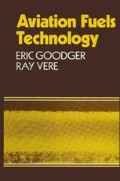Abstract
Aviation has become firmly established internationally both as a prime mover of passengers and a significant handler of freight. Journey times benefit from the characteristically high flight speeds, and also from direct routeing unimpeded by coastlines or mountain ranges. The high operating altitudes, while imposing their own problems of atmospheric conditions, minimise the costly and uncomfortable effects of weather. Since the vehicle has to be supported as well as propelled, the energies involved in aviation are high in comparison with slower forms of transport, with values of payload-range per fuel litre reaching only 0.06 and less than 0.01 respectively of the corresponding values for buses and supertanker ships. The impact of recent turbulences within the oil world has underlined the key role of the fuel element in airline technical accounting, and in effective military operations. In civil aircraft, for example, the (fuel/direct operating) cost ratios have increased from 0.25 in the early 1970s to about 0.60 today. The cost effectiveness of aviation fuels is therefore a key factor in the future viability of aviation in general, and the airline industry in particular.
Preview
Unable to display preview. Download preview PDF.
Author information
Authors and Affiliations
Copyright information
© 1985 Eric Goodger and Ray Vere
About this chapter
Cite this chapter
Goodger, E., Vere, R. (1985). Introduction. In: Aviation Fuels Technology. Palgrave, London. https://doi.org/10.1007/978-1-349-06904-0_1
Download citation
DOI: https://doi.org/10.1007/978-1-349-06904-0_1
Publisher Name: Palgrave, London
Print ISBN: 978-1-349-06906-4
Online ISBN: 978-1-349-06904-0
eBook Packages: EngineeringEngineering (R0)

